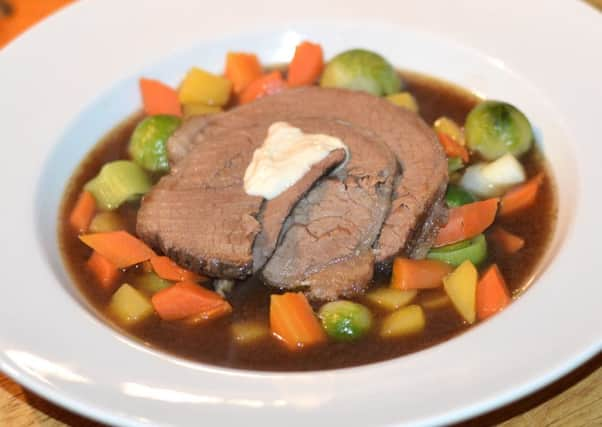RECIPE: Take time for perfect brisket


Part of the booty from the Normans’ victory at the Battle of Hastings in 1066 was the best cuts of the beast. And they gave them French names, just to let the defeated English know who was going to eat what.
In the Middle Ages what you ate, depended on what you spoke. From the French we get the prime, expensive, cuts, such as fillet, loin or haunch. Middle English, from its Germanic and Norse roots, left us with the tougher leftovers of shin, rump, or neck.
Advertisement
Hide AdAdvertisement
Hide AdAlso left to the English was brisket. Its name coming from the rather unappetising Old Norse ‘brjósk’, meaning gristle or cartilage. It’s certainly a tougher piece of meat. When alive, it does the heavy lifting, helping to carry about most of the weight of the animal. But when it comes to meat, work in life means flavour on the plate.
Brisket has a rich, savoury, intense flavour, which releases perfectly with long, slow cooking. The sinews and connective tissue slowly melt away into one of the best beef gravies you can get, leaving a meat that’s tasty, robust and warming.
After the expenses of Christmas, brisket, which is at least half the price of prime cuts, is the perfect economical cut with which to start the new year. Take your time with the cooking – this is one that really can’t be rushed – and it’s a perfect for a slow cooker. Serve with the best of the winter vegetables.
Ingredients (serves 4)
1kg/2lb rolled beef brisket
1 chopped onion
1 chopped carrot
2 sticks chopped celery
Glass red wine
2 pints beef stock
Tablespoon English mustard
Splash of Worcestershire sauce
Squirt of brown sauce
Spring of rosemary
Seasonal vegetables to serve
Method
Place the brisket in a deep casserole dish with the chopped onion, carrot and celery. Mix the beef stock with the wine, mustard, Worcestershire sauce and brown sauce and pour over the meat. Top up with water if needed to cover the meat. Add the rosemary and a good twist of pepper.
Advertisement
Hide AdAdvertisement
Hide AdWith the lid on, place the casserole in the oven at 140C for 5 to 6 hours. The meat should be tender when poked with a knife.
Remove the meat and allow to rest in foil for 30 minutes. Strain the rich liquor, removing all the stock vegetables. Keep warm in a pan and season to taste.
To serve, slice the beef and serve in a dish, with the vegetables and the rich gravy.